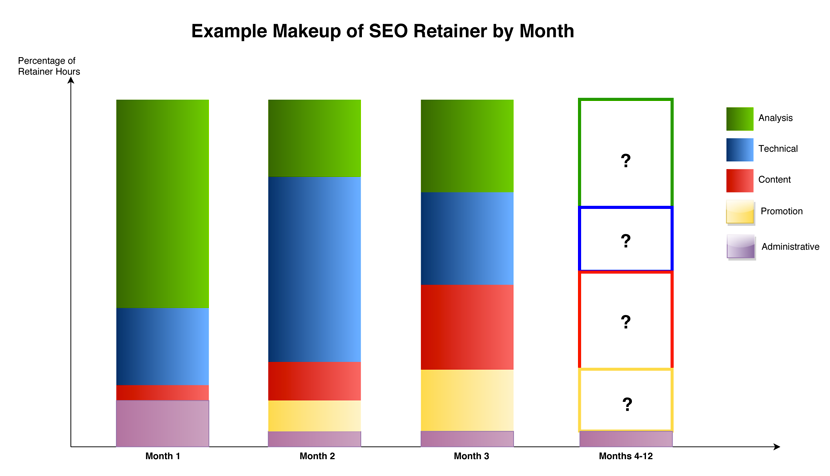Wondering exactly what is included in that monthly SEO retainer?
The number one answer to this and many other SEO questions is:
“It depends…”
 Every business and website is unique (or should be), and has different needs. That is not some feel-good marketing babble intended to make you feel special. That’s just how it is. Most SEOs would love it if our job was so easy that we could just do the same thing for every website. The truth is that nearly every factor that leads to good search engine rankings and traffic depends on many other things, and there are very few times when there is just one thing that is the key to success. This is true all the way from the planning stages to the little technical details.
Every business and website is unique (or should be), and has different needs. That is not some feel-good marketing babble intended to make you feel special. That’s just how it is. Most SEOs would love it if our job was so easy that we could just do the same thing for every website. The truth is that nearly every factor that leads to good search engine rankings and traffic depends on many other things, and there are very few times when there is just one thing that is the key to success. This is true all the way from the planning stages to the little technical details.
Why are the details so vague?
With so many so-called SEOs trying to separate you from your money, many people are quick to assume that when the SEO seller does not give exact details of what would be done, that they are hiding something. Sometimes this is true, but even the best SEO consultant can not tell you what they don’t already know. So when you ask “how many links will I need?” or “which keywords are the best?” or even “how many blog articles will you write?” before anyone has started working on the project, any answer given would be speculation. Hopefully, that speculation comes from experience and research and not just “everyone says this is how it works so let’s run with that.”
SEO – It’s Just Not That Simple:
There are some SEO providers who do still offer packaged plans which include a one-time optimization of a fixed number of pages, a fixed number of blog post, and a count of links that will be built monthly, weekly or even daily. These one-size-fits-all SEO packages may work for some sites, but not very well – and may get your site in trouble with Google if rules are broken. If your website is very specialized, say you are selling organic bamboo TV remote control holders, not only would you probably not need anything more to rank well in google for that than a site that works – but where is your SEO going to find 100 relevant sites to link to yours every month?!
It would be great if we could just say “Oh, you want yoursite.com to rank number one for 5 high traffic keywords. OK, we will rewrite your title tags, install a plugin, and get 10 backlinks per week like we did for the last 10 sites.” But it just doesn’t work that way. Good search engine visibility is a moving target, and the methods used to get your site there are constantly changing, too.
How Our Process Addresses This:
I can’t speak for the rest of the SEO world, but when I put together a proposal for Ker Communications SEO services, I try to give an overview that is as detailed as possible and outline key areas on which we will focus in the beginning, along with changes you should expect to the overall makeup of the campaign as it evolves. Those “details” are still going to be a little more vague than you may like. What Ker Communications will do for your site will not be the exact same thing every month. For example, after an initial audit, we may find that there are a few hundred pages of duplicate content to wrangle, and that there are several other on-page technical issues to resolve. Based on what is known about the site, we can estimate the amount of time will be needed to do that. We also know that while that is being done, more things will be found to improve which will make a difference. We try to account for the known and the unknown in our estimates.
We will be looking at the content on the site for ways to improve it. At the time of the proposal, we may know how much content there is, but we have not put in the hours it will take to analyze it, or make any changes that are needed. While writing our proposal for SEO services, we can estimate the time needed to optimize what you already have. But analyzing the effects of optimization is an ongoing thing with some trial and error. Make changes and wait for Google to pick them up, see what happens in the search results, see what happens with the visitors that brings to the site, and adjust if necessary.
If we will be handling “off site” promotion, we can take a look at the competition and get a pretty good idea of what will need to be done… or not. Just because the competition broke a lot of Google’s rules and bought thousands of links does not mean we should do that for you. Just because they spam Twitter with self-promotional links 50 times a day does not mean you should do the same. But we can get a feel for how much effort they are putting into online marketing, and what we’ll need to do to compete.
Whenever possible, it is best to get as much of the technical and content optimization under control before committing to a specific amount of time that would be allocated to “external” things like social media, PR outreach or any link building. What an SEO consultant thinks you will need off-site at the beginning can be quite different from what is really needed after just some of the on-page work is completed.
This is all still too vague for most people who are used to hiring someone to do a specific set of tasks, so we try to include some examples of the types of things we will be doing at various stages.
The SEO Retainer:
Rather than have to renegotiate the budget and the exact tasks to be done each and every month, Ker Communications uses a retainer arrangement for longer SEO and inbound marketing campaigns.
It is all about time. The amount we quote for an inbound marketing campaign or SEO retainer is the cost to reserve Ker Communications to do the work required to achieve your goals. This is based mostly on the amount of time we will need to complete the tasks we know about (with some room for those we don’t know about yet). But it is also based on a reasonable timeframe in which we can achieve the goals of the campaign, as well as the client’s budget.
For example:
- We know yourwebsite.com needs about 40 hours of development work to do the things we already know need to be done.
- We know how long it takes us to set up and configure Google Analytics and our own customized reporting dashboards.
- We know how much time will typically go into reports, phone calls, meetings, etc.
- We know the best strategy for yourwebsite.com will include a weekly “how to” article, and active promotion of it in social media – and we know how much that will cost to produce and execute.
- We know yourwebsite.com currently has 250 pages and you plan to add 6 more over the next few months.
- We know yourwebsite.com is in a competitive niche that will take at least a year to get consistent page one results for the most competitive search terms.
- We know your monthly budget for search engine marketing, and what we can do with that amount in regard to the above items.

Note that Analysis is always a large portion. SEO is not one size fits all, so we constantly analyze your site, search results, traffic, competition and more…
Based on that, we come up with 12 months in which we will need to put in about 20 hours per month on analysis, optimization, content and promotion (the percentage of each component will change from week to week). Add to that, a few hours of administrative stuff (reports, phone calls, etc), and a few more hours for “unknowns”. Our job is now to optimize the work process to get the best results as soon as possible. The exact make-up of this will vary from one site to the next, but a monthly breakdown of what yoursite.com will get for its budget might look like this:
Month 1:
Initial Analysis & Strategy Development.
Analytics & Dashboard Set Up.
Start on critical fixes which we can see right away.
Month 2:
Primarily focus on fixing technical issues found in initial analysis.
Start optimizing original content.
Set up social media profiles.
Write new blog posts.
Promotion using social media, outreach, or other ways to acquire the attention we need – links, social shares, press mentions, etc.
Month 3:
Continue content optimization.
Promotion.
More blog posts and other valuable content.
Continued Analysis – monitor effects of previous work, look for new areas of improvement and possibly shift the primary focus of the work from one area to another based on what we learn.
Revisit on-page technical work based on what we learn from analysis.
Months 4-12:
Some combination of any/all of the above based on ongoing analysis.
Sometimes we will need to spend a lot of time on technical things. Other times, content, promotion or even analytics will require more attention. Or maybe something happens in the news that is related to your industry, giving us the opportunity to establish you and your company as an authority on the topic.
The SEO retainer agreement allows us the flexibility to do whatever is needed within a given month by effectively prioritizing tasks to fit the time allowed by the budget. We are constantly analyzing the site, its traffic and the actions we have taken. That makes for a very agile online marketing campaign that gets great results – even if we were not able to give you an exact list of every task in advance.
Agile SEO
Sometimes we need to change the plans on the fly due to unexpected changes in your business or industry, or due to new developments online. For example, we are just a few weeks away from what is expected to be one of the biggest changes in Google’s organic search algorithms ever – the Mobile-Friendly Update. Websites that are not mobile-friendly will be shown less often in search results on phones and tablets. So this month, some of our clients’ sites are being made responsive if for some reason they are not yet mobile-friendly. For those sites, maybe mobile traffic was OK and other things were a priority before the update was announced. Now, it is a priority in terms of SEO, so even if the site’s in-house development wasn’t planning on updating for a while – we’re on top of it (or on the dev team’s back to get on it).
Will a bigger budget get faster or better results?
It depends. If the initial budget is just enough get everything done every month, then budgeting for more time can help speed things up. For example, yoursite.com has 250 pages that need to be optimized. The sooner we can get all of that finished, the sooner we can spend more time on other things – but it doesn’t make much sense to finish that without resolving technical problems which may prevent Google from seeing those pages in the first place. If we can allocate more time to the project, we can get the technical issues resolved faster, and optimize the content sooner.
We can also go the other direction for a lower budget, if you don’t mind the total project timeline being longer.
Known knowns, known unknowns, and the unknown unknown
Donald Rumsfeld is probably not someone to look to for straight-talk, clarity of meaning, and trustworthiness, but I like how this quote fits the vague nature of SEO:
“There are known knowns. These are things we know that we know. There are known unknowns. That is to say, there are things that we know we don’t know. But there are also unknown unknowns. There are things we don’t know we don’t know.”
Sometimes the nature of inbound marketing and SEO is vague, not because we want it to be, but because it just is.



